A deeper understanding of the biological role of sugar molecules is transforming drug design. Susan Aldridge finds out more
Genomics – the study of genes and their functions – was the first word in a new language for molecular biologists. Today, the ’omics lexicon includes proteomics (proteins), metabolomics (metabolism), nutrigenomics (genes and nutrition), pharmacogenomics (genes and drugs) – and now glycomics (carbohydrates). With the ’omics approach, large-scale molecular maps are created – like the human genome – and the focus is on reaction pathways and networks, rather than individual biochemical reactions. It relies on new high-throughput technologies such as robotics and microarrays.

That carbohydrates have gained entry into the ’omics club shows how far our understanding of the role of sugar molecules in biology has advanced in recent years – and just how important that role is.
It is now clear that the significance of glycans – carbohydrates with a biological role – extends far beyond the long-understood energy-producing reactions of glucose. Glycans often decorate the surface of protein and lipid molecules, the combination being called a glycoconjugate. But they are much more than the icing on the cake – their branch-like structures reach across the gap between molecules, facilitating cell-to-cell communication, immunity and inflammation, infection and the progression of cancer. 'Nature uses carbohydrates to control many processes,’ says Richard Storer, chief scientific officer at Summit, a UK biotechnology company that aims to harness those processes and develop a new range of carbohydrate drugs.
Glycans are the largest and most diverse group of molecules found in nature. Cellulose, a principal component of plant cell walls, is the most abundant organic compound on Earth, with around 1015 (one thousand trillion) kg being synthesised and broken down annually. Second is chitin, the main structural ingredient in the exoskeletons of spiders, insects, lobsters and crabs. Then there are pectins, carbohydrates that also occur in plant cell walls, which act like cement giving fruits their shape, and ground substance – a complex mix of glycosaminoglycans (GAG) and protein that occupies the extracellular space of cartilage, tendon, skin and blood vessels, providing them with a supportive and supple structural scaffold.
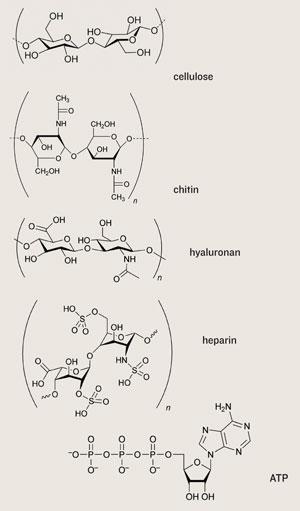
Smaller glycans include adenosine triphosphate (ATP) and related phosphorylated molecules – providing the molecular currency for energy generation and transfer, and deoxyribose and ribose, which are essential components of DNA and RNA.
The traditional classification of carbohydrates is based on the number of simple sugars, like glucose or fructose, that are linked together in the molecule. Monosaccharides have one unit; disaccharides, two units (like sucrose); polysaccharides are polymers, like cellulose. The term oligosaccharide is often used to describe medium length sugar chains.
The name carbohydrate refers to the general empirical formula Cn(H2O)n- or hydrated carbon – which applies to glucose (C6H12O6) and many other sugars. However, many sugars in glycoconjugates, such as fucose and rhamnose, do not fit the simple formula and some, like glucosamine and galactosamine, even contain nitrogen – making them amino sugars, which are the major component of the GAGs.
Mix and match
Most monosaccharides contain at least one asymmetric carbon atom, and the orientation of the glycosidic bond linking them in oligosaccharides also varies, meaning that the number of possible stereoisomers escalates rapidly with molecular weight. Glucose alone has 64 stereoisomers, while sucrose has 512. The mix and match possibilities of nature’s sugar building blocks gives rise to some staggering figures for glycan structures – there are 15 million possible ways of making a tetrasaccharide out of the nine most common monosaccharides found in nature. There are also options for branched structures, because of the number of functional groups hanging from the carbon backbone of sugar units. The sheer complexity of glycans makes the structures of genes and proteins look rather ordinary by comparison.
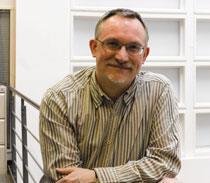
Like the genetic code of DNA, glycans carry biological information. 'The huge array of sequence and structural information has an effect on protein function through glycan-protein binding,’ says Tony Day of the Wellcome Trust Centre for Cell-Matrix Research at the University of Manchester, UK, who is studying the biology of GAGs. That is why a multi-national team, the Consortium for Functional Glycomics, has taken on the mammoth task of assembling the Human Glycome – the whole complement of glycans contained in our cells.
Most proteins are glycosylated, with the links being made enzymatically through the side chains of asparagine residues (N-glycosylation) or a serine, threonine or hydroxy-proline residue (O-glycosylation). Correct glycosylation is essential to biological function, as glycans control many properties of a protein, including its folding into the correct three-dimensional structure, its stability, secretion from the cell, cell signalling, and protein-protein interactions. And getting this glycosylation pattern right can be a major challenge for biotech manufacturers putting the finishing touches to advanced drugs like recombinant proteins or monoclonal antibodies.
Sugar talks
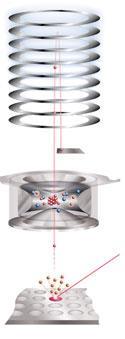
Glycoproteins are basic components of the cell membrane, with the oligosaccharides reaching out from the cell surface like antennae, acting as ligands for specialised carbohydrate-binding proteins called lectins. The reversible binding of a lectin to its glycan ligand on a cell surface is a first step in many biological processes involving cell-cell communication and interactions, such as fertilisation, the spread of cancer, and the early stages of inflammation. In the latter, interaction between a type of lectin called a selectin and a tetrasaccharide called sialyl-Lewis-X causes leucocytes in the circulation to slow down and then attach themselves to the endothelial cells that line blood vessels near the site of an injury. Interrupting this interaction using selectin inhibitors could provide a new class of drug for chronic inflammatory disease. Revotar Pharmaceuticals in Germany is developing a synthetic sugar mimic called bimosiamose for this purpose.
Glycans are also important in infection. Bacteria, viruses and parasites may use lectins on their cell surface as a ’key’ to open a sugar ’lock’ on a host cell surface. For instance, influenza virus depends on interactions with sialic acid to complete its life cycle. Tamiflu – the drug currently being stockpiled against a potential bird flu pandemic – works by blocking an enzyme involved in this sugar-virus binding.
A better understanding of glycan interactions could also lead to new cures for tropical diseases. Rhoel Dinglasan and his team at the Johns Hopkins Bloomberg School of Public Health, Baltimore, have identified the glycan chains lining the mosquito’s gut which provide a 'hook’ for lectins on the Plasmodium parasite which causes malaria. Blocking the production of these glycans stopped the parasite from multiplying inside the insect that transports it, potentially providing a radical new approach to treating malaria. 'One approach is to develop anti-glycan based vaccines against malaria,’ says Dinglasan. ’And there’s some evidence from our own work that this is possible.’ This work highlights how widespread the role of glycans in disease may be. 'Glycans may not only play a specific role in microbial pathogenesis: they may also be – or generate – surrogate biomarkers of disease. There is also quite a bit of evidence for the importance of glycans in cancer and the development of cancer therapeutics.’
Tumour cells often display unusual glycans on their surfaces, opening up the possibility of using these sugars as targets for a vaccine. Following vaccination, the immune system would raise antibodies to the cancer-associated glycans which could target tumour cells, stimulating other immune cells to destroy them.
Day believes the changes in GAGs with ageing may play an important role in many diseases, such as age-related macular degeneration (the leading cause of blindness), diabetes, heart disease and arthritis. His current work is focused on how the microenvironment of GAGs can influence protein function. 'There’s good evidence that a protein’s function is modified by the glycan it binds to, and this is probably fundamental as GAGs are found in all tissues and fluids,’ he says.
Delicate measurement
The new understanding of glycans owes much to advances in technologies for structure determination and synthesis of these complex molecules. Improvements in the sensitivity and mass range of mass spectrometry (MS) have been especially significant. Matrix assisted laser desorption ionisation (MALDI) or electrospray ionisation (ESI) allow the application of MS to glycans and other large biological molecules because they are ’soft’ ionisation techniques – less likely to cause fragmentation of these delicate structures.
MALDI is used with Time of flight (TOF) MS analysis which is suited to the pulsed nature of the laser and displays the full mass range in real time. But MALDI-TOF has limitations, not least because many monosaccharides have similar molecular weights. Japanese biotechnology company Shimadzu’s AXIMA-QIT system incorporates a quadrupole ion trap with MALDI-TOF which allows multi-stage 'tandem’ MS. The ion trap allows the isolation of an ion of interest for further fragmentation and a further round of MS. ’A lot of instruments do MS-MS but it ends there,’ explains sales support manager, Rachel Martin. 'We do MS to the power of n and in each round an ion of interest is further fragmented and analysed. We can then piece the fragments together to drill down much further into the glycan structure.’ The approach has been applied to some challenging glycan structures. Shimadzu is now working with the newly established Japanese Research Centre for Medical Glycoscience on the identification of glycan biomarkers of disease in clinical samples.
Nuclear magnetic resonance (NMR) is also making a useful contribution. David Reid at the University of Cambridge, UK, working with the Animal Health Trust in Newmarket, and the BAM Federal Institute of Materials Research and Testing, in Berlin, Germany, has shown that GAGs constitute and stabilise the boundary between the organic and inorganic phases of bone, giving it toughness and stiffness. This discovery was made possible by rotational echo double resonance, a specialised type of solid state NMR. 'We came to the conclusion that the molecules closest to the mineral surface in bone were glycans from the fact that their NMR frequencies were completely compatible with their being sugars, but not proteins,’ says Reid. 'We reinforced this idea with data from related tissues like articular and mineralised cartilage, and pure glycosaminoglycans like chondroitin sulfates. All these materials show signals at the same C13 NMR frequencies as our mineral bound minerals in bone. Proteins, like collagen, the most abundant protein in bone, don’t.’ The research opens up new ways of treating bone disorders, like osteoporosis, including the rational design of bone replacement and regeneration materials.
There has also been an increase in the ability of biochemical tools to investigate and manipulate glycans. Dinglasan says that, in his malaria work, he used antibodies that specifically identify chondroitin or heparin sulfates (both GAGs) on cell surface proteoglycans. They then used biotinylated chondroitin disaccharides purified from tissue to stain the parasites in vitro. 'These are all very basic techniques that are often overlooked as practical approaches to study protein-glycan interactions,’ he says.
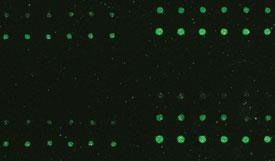
Storer adds: 'the general development of more sophisticated screening techniques that use much smaller amounts has made a big contribution to the biological side of screening.’
Meanwhile, microarray technology allows high throughput analysis of glycan-protein interaction. The technology is being pushed forward by the UK GlycoArray Consortium (Universities of Edinburgh, Dundee, East Anglia, London and Oxford). A glycoarray is a multi-well plate where each well contains a different glycan fixed to its surface. Exposure to a protein linked to a fluorescent dye allows a scan of all the glycan-protein interactions. Glycoarrays can look at the differential expression of glycans on tissues in health and disease and at differing stages of development.
Even simple sugars are hard to synthesise with stereochemical purity, especially when using traditional synthetic organic chemistry, although solid phase synthesis – as used with peptides – is one promising way forward. Another approach is to use the glycosyltransferases which assemble glycans in nature. However, the sugar nucleotide substrates needed for these enzymes are expensive and not always readily available. Stephen Withers at the University of British Columbia, Vancouver, has found that nitrophenyl glycosides can be used as acceptable and cheaper alternatives. He is also carrying out molecular engineering, including directed evolution, on glycosyltransferases to extend the repertoire of these useful glycan synthesis tools.
'Enzymatic synthesis of glycans is always easier than chemical synthesis, assuming the enzyme is available,’ says Withers. 'The enzyme does all the regiochemistry for you, and it is a green approach.’ However, a lot of work, including cloning, goes into getting these enzymes. 'My dream is a strategy to get a library of enzymes that will give us all the oligosaccharides we want. It is only a dream – but I think it will come.’
'There have been amazing advances in synthesis,’ says Storer. 'However, chirality does cause major synthetic problems, so carbohydrates will never be easy to work with.’ To this end, Summit bought Dextra, a UK company that specialises in carbohydrate synthesis. It hopes to leverage Dextra’s expertise in the discovery and development of a new generation of carbohydrate-based drugs.
The sweet solution to a pandemic
Ram Sasisekharan and his team at Massachusetts Institute of Technology have shown recently that a deeper understanding of glycan structure could be the key to preventing a potential pandemic of avian influenza caused by the H5N1 strain.
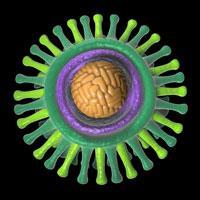
We already know that infection with the flu virus involves binding between haemagglutinin (HA) molecules on the surface of the viral particle to glycans in the respiratory tract. Human adaptation of avian flu virus involves a shift in HA binding from a 2-3 sialylated glycans to the a 2-6 sialylated glycans which are extensively expressed in human airway tissue. Yet this isn’t the whole story – some avian viruses that can bind to a 2-6 glycans are not infectious in humans.
Sasisekharan’s team revise this paradigm by showing that the presence of a a 2-6 linkage alone is inadequate to explain human adaptation, and that the critical determinants are glycan topology. Using a combination of lectin binding studies, crystallography, MALDI-MS and data mining of glycoarrays, Sasisekharan has revealed that glycan topology (the shape assumed by the flexible sugar chains in a glycan) is the key factor in human adaptation of avian flu viruses like H5N1 through HA.
Two types of topology are involved – cone-shaped and umbrella-shaped. Binding of HA to the former shape is involved in bird infection and to the latter shape in human infection. A virus that cannot recognise and bind the umbrella shape is unlikely to be able to infect humans. ’It is the shape of the glycan which plays a more critical role.’ says Sasisekharan.
The findings open up the possibility of rapid and more accurate monitoring of strains of bird flu for their potential to infect humans, via glycan arrays bearing the requisite umbrella-shaped molecules. Drugs whose structures are based on the umbrella-shape could also be used as ’decoys’ to block flu virus infection. Finally, a better understanding of the way bird viruses adapt could lead to the design of more effective flu vaccines. Sasisekharan believes that binding of HA to specific glycan shapes may also extend our understanding of other viral infections.
There are already many well-known drugs in this class – the anticoagulant heparin, for instance, and various anti-viral nucleoside analogues. The problem with these drugs is that they often lack selectivity. Conventional heparin, for instance, is a poorly characterised mixture of polysaccharides with varying potency and many unwanted side effects. A determination of heparin’s sequence has led to the development of a new low molecular weight version which is a much ’cleaner’ product.
Summit is developing a new class of drugs based upon imino sugars, a class of carbohydrates found in the water-soluble fraction of many herbal medicines which may be responsible for their pharmacological activities.
'Many people did not believe in these water-soluble drugs at first,’ says Robert Nash, Summit’s director in Wales and a leading phytochemist. 'In fact, the gastrointestinal tract is good at taking up these small sugar-like molecules.’ One group of these new drugs are pyrrolizidines which prime the immune system by mimicking a microbial cell wall. 'It upregulates type I immune response to cancer cells which are otherwise depressed by the tumour,’ explains Storer.
For the new generation of glycan-based drugs, this is just the beginning. In the future, there will be an even wider selection of compounds and
deeper insights into how they work in the cell. As Nash puts it, 'The future holds great promise for carbohydrate-based drugs, and not just in imino sugars – there are tremendous opportunities out there.’
Susan Aldridge is a freelance science writer based in London, UK






No comments yet